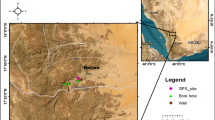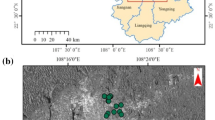Abstract
In recent decades, agricultural plains have been subject to significant subsidence in different parts of the world including Iran. Tehran plain is one of these parts exposed to land subsidence. In this paper, as the most effective method to monitor the subsidence, synthetic aperture radar interferometry (InSAR) makes use of two radar images to measure the ground surface deformation between two acquisitions. For this purpose, two different radar datasets including 16 ENVISAT ASAR images spanning from 2003 to 2008 and 12 Sentinel-1A images spanning from 2016 to 2017 were applied in InSAR small baseline subset (SBAS) time series analysis. Two distinct subsidence time series achieved from the two datasets were integrated using an appropriate model which was fitted to all data obtained from two time series results from 2003 to 2017 and verified running leveling measurements. The average value of the root mean square errors (RMSEs) calculated between the model and the achieved time series at all pixels is 0.02 m which is an illustration of the accuracy of the proposed model to join the two deformation time series results. Furthermore, the integration results were additionally used to discover the storage properties of the aquifer system by stress–strain relationship and the effect of aquitard thickness on subsidence of Tehran plain by subsidence-aquitard thickness (fine-grained interbed) relationship, respectively. The stress–strain relationship shows a low correlation between subsidence and groundwater exploitation where a direct relationship between subsidence and aquitard thickness is clearly obvious.











Similar content being viewed by others
Availability of data and material
European Space Agency (ESA) provided the InSAR and Sentinel-1A images.
Code availability
The MATLAB code is used.
References
Castellazzi P, Arroyo-Domínguez N, Martela R, Calderhead A, Normand J, Gárfias J, Riverad A (2016) Land subsidence in major cities of Central Mexico: interpreting InSAR-derived land subsidence mapping with hydrogeological data. Int J Appl Earth Obs Geoinf 47:102–111
Chaussard E, Amelung F, Abidin H, Hong SH (2013) Sinking cities in Indonesia: ALOS PALSAR detects rapid subsidence due to groundwater and gas extraction. Remote Sens Environ 128:150–161
Chaussard E, Wdowinski S, Cabral-Cano E, Amelung F (2014) Land subsidence in central Mexico detected by ALOS InSAR time-series. Remote Sens Environ 140:94–106
Chen B, Gong H, Chen Y, Li X, Zhou C, Lei K, Zhu L, Duan L, Zhao X (2020) Land subsidence and its relation with groundwater aquifers in Beijing Plain of China. Sci Total Environ 735:139111
Dehghani M, Valadan Zoej MJ (2013) Entezam I (2013a) neural network modelling of Tehran land subsidence measured by persistent scatterer interferometry. Photogramm Fernerkun Geoinf 1:5–17
Dehghani M, Valadan Zoej MJ, Entezam I, Mansourian A, Saatchi S (2009a) InSAR monitoring of progressive land subsidence in Neyshabour, Northeast Iran. Geophys J Int 178:47–56
Dehghani M, Valadan Zoej MJ, Saatchi S, Biggs J, Parsons B, Wright T (2009b) Radar interferometry time series analysis of Mashhad subsidence. J Indian Soc Remote Sens 37:191–200
Dehghani M, Valadan Zoej MJ, Hooper A, Hanssen RF, Entezam I, Saatchi S (2013) Hybrid conventional and Persistent Scatterer SAR interferometry for land subsidence monitoring in the Tehran Basin Iran. ISPRS J Photogramm Remote Sens 79:157–170
Funning GJ, Parsons B, Wright TJ, Jackson JA (2005) Surface displacements and source parameters of the 2003 Bam (Iran) earthquake from Envisat advanced synthetic aperture radar imagery. J Geophys Res 110:1–23
GSI, Geological Survey of Iran (2008) Geotechnical Study in Southwest Plain of Tehran, 543 pp (in Persian).
Hosseini Alaee N, Mozafari A, Mirzaee M, Faghihi A, Tolouei K (2019) Fuzzy evaluation method for the identification of subsidence susceptibility in an underground mine (case study in Tabas coal mine of Iran). Nat Hazards 99:797–806
Jong-Gwan K (2020) Measurement of surface subsidence and ground collapse caused by underground mining in the Boleo Copper District, Mexico. J Sust Min 19(2):6
Khan AS, Khan SD, Kakar DM (2013) Land subsidence and declining water resources in Quetta Valley, Pakistan. Environ Earth Sci 70:2719–2727
Lazecky M, Comut FC, Bakon M, Qin Y, Perissin D, Hatton E, Spaans K, Mendez PG, Guimaraes P, de Sousa JJM, Kocich D, Ustun A (2016) Concept of an effective SENTINEL-1 satellite SAR interferometry system. Procedia Comput Sci 100:14–18
Liu Z, Cui B, Liang Y, Guo H, Li Y (2019) Study on foundation deformation of buildings in mining subsidence area and surface subsidence prediction. Geotech Geol Eng 37:1755–1764
Luna RMR, Anjos Garnés SJ, Silva Pereira Cabral JJ, Santos SM (2017) Groundwater overexploitation and soil subsidence monitoring on Recife plain (Brazil). Nat Haz 86:1363–1376
Lu L, Fan H, Liu J, Liu G, Yin J (2019) Time series mining subsidence monitoring with temporarily coherent points interferometry synthetic aperture radar: a case study in Peixian, China. Environ Earth Sci 78:461
Lyu HM, Shen ShL, Zhou A, Yang J (2019) Risk assessment of mega-city infrastructures related to land subsidence using improved trapezoidal FAHP. Sci Total Environ 717:135310
Mahmoudpour M, Khamehchiyan M, Nikudel MR, Ghassemi MR (2016) Numerical simulation and prediction of regional land subsidence caused by groundwater exploitation in the southwest plain of Tehran, Iran. Eng Geo 201:6–28
Martínez JP, Hernandez-Marín M, Burbey TJ, González-Cervantes N, Ortíz-Lozano JA, Zermeño-De-Leon ME (2013) Land subsidence and ground failure associated to groundwater exploitation in the Aguascalientes Valley, México. Eng Geo 164:172–218
Minderhoud PSJ, Coumou L, Erban LE, Middelkoop H, Stouthamer E, Addink EA (2018) The relation between land use and subsidence in the Vietnamese Mekong delta. Sci Total Environ 634:715–726
Modoni G, Darini RL, Spacagna M, Saroli G, Russo PC (2013) Spatial analysis of land subsidence induced by groundwater withdrawal. Eng Geo 167:59–71
Mohammady M, Pourghasemi HR, Amiri M (2019) Assessment of land subsidence susceptibility in Semnan plain (Iran): a comparison of support vector machine and weights of evidence data mining algorithms. Nat Haz 99:951–971
Motagh M, Djamour Y, Walter TR, Wetzel HU, Zschau J, Arabi S (2007) Land subsidence in Mashhad Valley, Northeast of Iran, results from InSAR leveling and GPS. J Geophys 168(2):518–526
Pallav KS, Narendra MS, Vishnu PP, Stephen JB, Sangam S (2017) Model-based estimation of land subsidence in Kathmandu Valley. Nepal Geomat Nat Haz Risk 8(2):974–996
Qin H, Andrews CB, Tian F, Cao G, Luo Y, Liu J, Zheng C (2018) Groundwater-pumping optimization for land-subsidence control in Beijing plain, China. Hydrogeo J 26:1061–1081
Rajabi AM (2018) A numerical study on land subsidence due to extensive overexploitation of groundwater in Aliabad plain, Qom-Iran. Nat Haz 93:1085–1103
Rateb A, Abotalib AZ (2020) Inferencing the land subsidence in the Nile Delta using Sentinel-1 satellites and GPS between 2015 and 2019. Sci Total Environ 729:138868
Salehi Moteahd F, Hafezi Moghaddas N, Lashkaripour GR, Dehghani M (2019) Geological parameters affected land subsidence in Mashhad plain, north-east of Iran. Environ Earth Sci 78:405
Sansosti E, Manunta M, Casu F, Bonano M, Ojha C, Marsella M, Lanari R (2015) Radar remote sensing from space for surface deformation analysis: present and future opportunities from the new SAR sensor generation. Rend Lincei Sci Fis Nat 26(1):75–84
Saowiang K, Giao PH (2020) Numerical analysis of subsurface deformation induced by groundwater level changes in the Bangkok aquifer system. Acta Geotech. https://doi.org/10.1007/s11440-020-01075-8
Simone F, Shimon W (2019) Local land subsidence in Miami Beach (FL) and Norfolk (VA) and its contribution to flooding hazard in coastal communities along the U.S. Atlantic coast. Ocean Coast Manage 187:105078
Smith R, Knight R (2019) Modeling land subsidence using InSAR and airborne electromagnetic data. Water Resour Res 55(4):2801–2819
Teatini P, Tosi L, Strozzi T, Carbognin L, Cecconi G, Rosselli R, Libardo S (2012) Resolving land subsidence within the Venice lagoon by Persistent Scatterer SAR Interferometry. Phys Chem Earth 40–41:72–79
Tichavský R, Jiránková E, Fabiánová A (2020) Dating of mining-induced subsidence based on a combination of dendrogeomorphic methods and in situ monitoring. Eng Geo 272:105650
TRWC, Tehran Regional Water Company (2012) Detailed Data Collection from Peizometric Wells. Springs, Tehran Province
Vernant P, Nilforoushan F, Chery J, Bayer R, Djamour Y, Masson F, Nankali H, Ritz J, Sedighi M, Tavakoli F (2004) Deciphering oblique shortening of central Alborz in Iran using geodetic data. Earth Planet Sci Lett 223:177–185
Wempen JM (2019) Application of DInSAR for short period monitoring of initial subsidence due to longwall mining in the mountain west United States. Int J Min Sci Technol 30(1):33–37
Yan X, Yang T, Xu, Y, Tosi L, Stouthamer E, Andreas H, Minderhoud P, Ladawadee A, Hanssen R, Erkens G, Teatini P, Lin J, Boni R, Chimpalee J, Huang X, Lio CD, Meisina C, Zucca F (2020) Advances and Practices on the Research, Prevention and Control of Land Subsidence in Coastal Cities. Acta Geol Sin 94(1):162–175
Yousefi R, Talebbeydokhti N, Afzali SH, Dehghani M (2019) Stress–strain analysis by genetic algorithm-based integration of longterm subsidence time series from different synthetic aperture radar platforms in Darab, Iran. J Appl Remote Sens 13(2):024520
Yusupujiang A, Fumio Y, Wen L (2018) Multi-sensor InSAR analysis of progressive land subsidence over the coastal City of Urayasu Japan. Remote Sens 10(8):1304
Zhao G, Guo W, Li X (2020) Mechanical Properties of Mega-Thick Alluvium and Their Influence on the Surface Subsidence. Geotech Geol Eng 38:137–149
Zhu L, Gong H, Li X, Wang R, Chen B, Dai Z, Teatini P (2015) Land subsidence due to groundwater withdrawal in the northern Beijing plain, China. Eng Geo 193:243–255
Zhu B, Chu Z, Shen F, Tang W, Wang B, Wang X (2019) Land subsidence (2004–2013) in Changzhou in Central Yangtze River delta revealed by MT-InSAR. Nat Haz 97:379–394
Acknowledgements
The authors wish to thank the European Space Agency (ESA) and the University of California at San Diego for providing the images data and GMTSAR software, respectively. They also convey their deep gratitude to the National Cartographic Center (NCC) of Iran for collecting the leveling measurements.
Funding
Not applicable for that section.
Author information
Authors and Affiliations
Corresponding author
Ethics declarations
Conflict of interest
The authors certify that they have no affiliations with or involvement in any organization or entity with any financial interest (such as honoraria; educational grants; participation in speakers’ bureaus; membership, employment, consultancies, stock ownership, or other equity interest; and expert testimony or patent-licensing arrangements), or non-financial interest (such as personal or professional relationships, affiliations, knowledge or beliefs) in the subject matter or materials discussed in this manuscript. In other words, they have no conflict of interest and no commercial benefits in this regard.
Additional information
Publisher's Note
Springer Nature remains neutral with regard to jurisdictional claims in published maps and institutional affiliations.
Rights and permissions
About this article
Cite this article
Yousefi, R., Talebbeydokhti, N. Subsidence monitoring by integration of time series analysis from different SAR images and impact assessment of stress and aquitard thickness on subsidence in Tehran, Iran. Environ Earth Sci 80, 418 (2021). https://doi.org/10.1007/s12665-021-09714-3
Received:
Accepted:
Published:
DOI: https://doi.org/10.1007/s12665-021-09714-3




